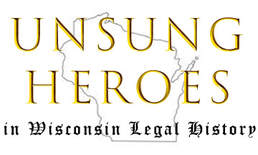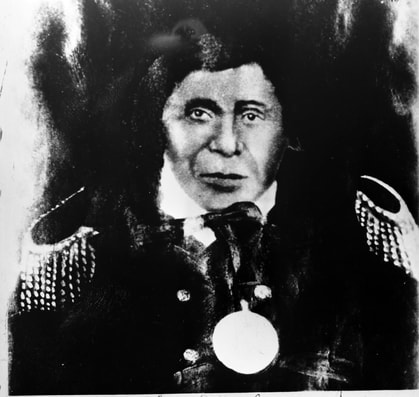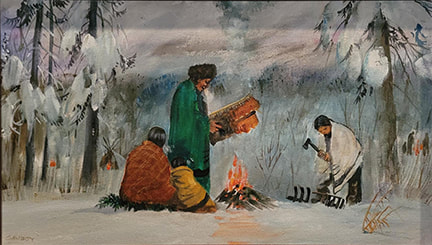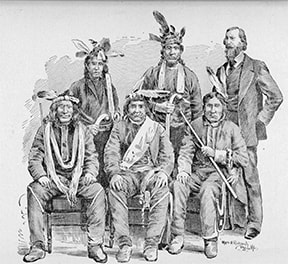 By Margo Kirchner Chief Buffalo was instrumental in the transfer of approximately one-third of Wisconsin from Indigenous Americans to the United States while retaining his people’s rights to live on reserved land and to hunt, fish, and gather. Chief Buffalo (also known as Great Buffalo, Kechewaishke, Gitchi waisky, or Pezheke) negotiated and signed a series of land-cession treaties between the Lake Superior Anishinaabe (also known as the Chippewa or Ojibwe) and the United States between 1837 and 1854. By the mid-1800s, Chief Buffalo was chief of all Lake Superior Anishinaabe and their lead treaty negotiator. He is best known for ensuring that the Anishinaabe would stay on their lands, even if those lands were significantly reduced in size, rather than move west of the Mississippi River. His work shaped the map of Wisconsin today, as the treaties he signed passed most of northern Wisconsin into United States control and eventually to White landowners. Chief Buffalo pursued a peaceful resolution despite treachery by the U.S. government that left about 400 Anishinaabe dead. While one could argue that the Anishinaabe relinquished too much in the treaties, Rob Goslin, a tribal elder of the Red Cliff Band of Anishinaabe and a historical interpreter for the Madeline Island Museum, confirms Chief Buffalo’s favorable place in his people’s history. Goslin says that Chief Buffalo knew changes were occurring as traders and settlers moved into northern Wisconsin, and he saw the issue as how to live among the new settlers rather than how to fight their presence. Goslin points to a saying he uses as a tribal elder and historical interpreter, which sums up Chief Buffalo’s thinking: “Teaching stays the same but the culture we live in changes.” When changes occur, “we have to live as we are today,” he says, and that was Chief Buffalo’s position. Chief Buffalo did the best he could with the situation before him, says Goslin. “He did his very best to look in the interest of his people.” Born in or about 1749 at La Pointe on Madeline Island (one of the Apostle Islands in southwestern Lake Superior), Chief Buffalo was a member of the Loon Clan, from which the highest-level chieftains of the Lake Superior Anishinaabe were chosen. Chief Buffalo rose to become what Goslin calls the “first chief” or “ultimate chief.” Several sources reference Chief Buffalo’s skill as a negotiator. An obituary of Chief Buffalo remarked that he was “noted for his rare integrity, wisdom in council, power as an orator, and magnanimity as a warrior.” Anishinaabe government was based on consensus, says Goslin, so Chief Buffalo had to discuss and mediate issues with the other clans’ chiefs as well as with the United States. The Minnesota chiefs in particular did not always agree with him. But in treaty negotiations, Chief Buffalo ultimately led the discussions. “He was a talker,” Goslin says. The Anishinaabe lived by hunting and trapping; fishing in Lake Superior, other lakes, and streams; gathering wild rice; and tapping maple trees for syrup. As European fur traders arrived in what is now northern Wisconsin, Michigan’s Upper Peninsula, and Minnesota, the Anishinaabe traded and intermarried with them. While other Anishinaabe tribal leaders urged physical aggression to resist the United States’ land acquisitions, Chief Buffalo relied on nonviolent negotiations and advocated for peace. Goslin says “that was one of the unique things about him—he was against bloodshed.” In the 1837 Treaty with the Chippewas, signed at St. Peters in Minnesota, and the 1842 Treaty with the Chippewas, signed at La Pointe, the Anishinaabe ceded land in eastern Minnesota, northern Wisconsin, and the western Upper Peninsula of Michigan. The portion of ceded land in Wisconsin alone totaled more than 22,000 square miles. In exchange, the Anishinaabe received certain sums to pay debts plus annual payments in cash and supplies for 20 (1837 treaty) and 25 (1842 treaty) years. The Anishinaabe retained their rights to hunt, fish, and gather on the ceded land, rivers, and lakes. Chief Buffalo participated in the 1837 and 1842 treaty negotiations and signed both treaties as chief of the La Pointe band of Anishinaabe. Historical reports indicate that the Anishinaabe believed they had sold only rights to timber and copper rather than the land itself, permanently. Ronald N. Satz, in Chippewa Treaty Rights: The Reserved Rights of Wisconsin’s Chippewa Indians in Historical Perspective, cites evidence that the acting superintendent of Indian affairs for the area assured the chiefs at the treaty council that they would not be asked to leave ceded lands for many years as long as they were peaceful and well-behaved. In a letter to the commissioner of Indian affairs in 1850, Chief Buffalo and other Anishinaabe chiefs recalled that during negotiations for the 1842 treaty, government officials said that the United States wanted the mineral rights to the land, not to settle it, and that the Anishinaabe would be able to live on their lands for 50 or even 100 years. They believed that although they had ceded their lands, they could remain living, hunting, and fishing there. United States officials thought otherwise. A new administration in the White House in 1845 brought a new commissioner of Indian affairs who wanted to move the Anishinaabe and others to a northern “Indian colony” to assist in westward expansion. As noted by Richard D. Cornell in The Chippewa: Biography of a Wisconsin Waterway, the commissioner also suggested evicting the Anishinaabe from northern Wisconsin to promote their “civilization.” The situation became dire in February 1850, when President Zachary Taylor revoked all hunting and fishing rights in the ceded territory and ordered the Anishinaabe to move from their lands around Lake Superior to west of the Mississippi River. Such removal would have taken the Anishinaabe away from their homelands and placed them in close proximity to the Dakota (also known as the Sioux), with whom the Anishinaabe had conflicted for more than a century. Chief Buffalo and other chiefs opposed to removal sent messengers to villages throughout their lands to confirm that the Anishinaabe had committed no incidents of aggression against White communities that could have justified removal. To push the Anishinaabe west, a Bureau of Indian Affairs agent and the territorial governor of Minnesota moved the location of the annual treaty payments of cash and supplies from La Pointe, Wisconsin, to Sandy Lake, Minnesota, and set the delivery for October 1850. The officials required all Anishinaabe families to appear to receive the payments, hoping to lure them to Minnesota and strand them there for the winter and possibly permanently. At least 3,000 Anishinaabe traveled hundreds of miles westward to Sandy Lake for the annuity payment. But when they arrived they found rancid and inadequate food, few supplies, and no cash payments. The Anishinaabe suffered six weeks of hunger and terrible conditions waiting for the annuity payments (which never arrived) before walking home, as winter had set in and rivers had frozen. About 170 Anishinaabe died at Sandy Lake from disease and starvation and another 230 died on the journey home. In November 1851 Chief Buffalo and several other Anishinaabe chiefs and headmen wrote to the commissioner of Indian affairs complaining of the acts of the Indian agent in Wisconsin as a “great deception towards us,” describing the suffering at Sandy Lake, asking that future annuity payments be made at La Pointe, and asking permission to send a delegation to Washington, D.C. Receiving no response to the request, in spring 1852, at age 93, Chief Buffalo set out to negotiate in person with U.S. President Millard Fillmore. (Taylor died in July 1850.) The party had not received permission for the journey from Washington officials, which was legally required at the time. Chief Buffalo, another leader named Oshoga, and four other Anishinaabe chiefs or braves, accompanied by translator Benjamin Armstrong (a White man who had married into Chief Buffalo’s family), traveled from La Pointe across Lake Superior in birchbark canoes. Along the way, they stopped at settlements and obtained petitions of support from the White community. When the party reached Sault St. Marie, Michigan, government officials tried to block their travel, saying Indians were not allowed to pass that point without permission from Washington. However, Chief Buffalo and his delegation persuaded the officials to let them pass. They traveled by steamer to Detroit, where another government official tried to hold them up. Undeterred, the party traveled by steamer to Buffalo, then by train and steamer to New York City and Washington. Having arrived without permission, Chief Buffalo and his delegation were initially denied access to the president by the commissioner of Indian affairs and the interior secretary. However, through a chance meeting with a senator and cabinet member in a restaurant, the party finally managed to secure a meeting with Fillmore. At the meeting, Chief Buffalo and Oshoga described their complaints about the removal order and Sandy Lake and negotiated the right of the Anishinaabe to remain on their lands in Wisconsin. After a day of deliberation, Fillmore said he would rescind the removal order and return annuity payments to La Pointe. Chief Buffalo and his delegation returned to Wisconsin by railroad. The meeting with Fillmore resulted in the 1854 Treaty with the Chippewa, signed in La Pointe. At age 95, Chief Buffalo signed the treaty as “1st chief” of all Lake Superior Anishinaabe. A plaque on Madeline Island today marks the spot of the signing. The 1854 treaty was the culmination of Chief Buffalo’s work as treaty negotiator. At the treaty council in La Pointe, Chief Buffalo and the other chiefs insisted on permanent lands for the Anishinaabe. Under the treaty, the United States abandoned its removal policy for the Anishinaabe and agreed to establish permanent reservations for them. The United States set aside tracts of land for Anishinaabe bands in Wisconsin, Minnesota, and Michigan and agreed that “the Indians shall not be required to remove from the homes hereby set apart for them.” Four Wisconsin reservations resulted: Bad River, Red Cliff, Lac Courte Oreilles, and Lac du Flambeau. (The St. Croix and Mole Lake reservations were created in the 1930s.) The 1854 treaty continued the Anishinaabes’ rights under the 1837 and 1842 treaties to hunt, fish, and gather. That “we would retain our community” was the important part of the 1854 treaty for the Anishinaabe, says Goslin. He adds that the best result for the Anishinaabe was to retain some land and the ability to sustain themselves. The Anishinaabe also secured annual payments for 20 years that included cash, household goods, agricultural implements and cattle, carpenters’ tools and building materials, blacksmiths, funds for a school, plus one-time supplies of guns and ammunition and a pay-off of certain debts. In addition, Chief Buffalo secured 80-acre land allotments and a one-time payment in goods and agricultural implements for “mixed bloods” of the Anishinaabe nation. Goslin says that starting with the arrival of the French, quite a bit of intermarriage took place, and Chief Buffalo wanted to ensure that anyone tied to the Anishinaabe people was included in treaty benefits. The 1837 and 1842 treaties had included one-time payments for mixed blood individuals; the 1854 treaty added land. The United States agreed in the 1854 treaty to pay all annuities to the Wisconsin Anishinaabe at La Pointe. Chief Buffalo died in 1855 and is buried at La Pointe Indian Cemetery on Madeline Island. Although the series of treaties ceded the bulk of Anishinaabe land to the United States, many Wisconsin Anishinaabe today celebrate the results of Chief Buffalo’s negotiations. In late September 2019 more than a dozen bands of Anishinaabe commemorated the 165th anniversary of the signing of the 1854 Treaty at a four-day gathering on Madeline Island, according to an article in the Sokaogon Chippewa Community News. The reservations continue to this day, as do the rights the Anishinaabe preserved in the series of treaties to hunt, fish, and gather. These rights, known as “usufructuary rights,” were the subject of tensions between the Anishinaabe and the State of Wisconsin and other Wisconsinites in the 1970s and 1980s. In 1972 the Wisconsin Supreme Court decided in favor of the Bad River and Red Cliff Bands of Anishinaabe and ruled that based on the 1854 treaty, the Anishinaabe retained the right to fish in off-reservation waters of Lake Superior without state regulation except for “reasonable and necessary” measures to protect against depletion of the lake’s fish population. In the decision, the Supreme Court noted that the 1854 treaty showed “a fundamental change in the government’s policy toward the Lake Superior Chippewa,” abandoning removal and establishing reservations instead. (State v. Gurnoe, 53 Wis. 2d 390 (1972).) Subsequently, Anishinaabe bands sued the State of Wisconsin in federal court, claiming interference with their treaty rights when Lac Courte Oreilles members were arrested for fishing off of reservation lands. In 1983 the U.S. Court of Appeals for the Seventh Circuit confirmed that the Anishinaabe retained their treaty-reserved usufructuary rights on non-reservation land except for land now privately owned. (Lac Courte Oreilles Band of Lake Superior Chippewa Indians v. Voigt, 700 F.2d 341 (7th Cir. 1983).) The court rulings triggered protests by Whites in northern Wisconsin. Protesters threw rocks at spearfishers, dragged heavy objects through spawning beds, blocked or swamped spearfishing boats, verbally harassed spearfishers, slung racial insults, threatened violence, and physically assaulted spearfishers and their friends and families. The state and the Anishinaabe now negotiate about usufructuary rights on topics such as how many fish can be speared inland and the details about fishing in Lake Superior, says Goslin. Several Anishinaabe bands established the Great Lakes Indian Fish & Wildlife Commission, which works with the state to manage Anishinaabe use of off-reservation resources. Today the Anishinaabe stock more fish in Wisconsin lakes than they take out. The treaties continue to form the legal basis of court cases and decisions. For instance, in April 2021 U.S. District Judge James Peterson found that taxation of Anishinaabe land is inconsistent with the permanency promised in the 1854 treaty. Peterson held that under the treaty’s terms the State cannot impose property taxes on land owned continuously by Anishinaabe, though it can tax property initially allotted to Anishinaabe individuals and later sold to others. (Lac Courte Oreilles Band of Lake Superior Chippewa Indians of Wisconsin v. Evers, Case No. 18-cv-992-jdp.) Please help us identify people and events that deserve more recognition for their place in Wisconsin’s legal history. You can send as much information as you want, but at minimum we need:
-The name of the person / identity or name of event -A picture, if available -A brief description of the person or event and the person or event’s impact on Wisconsin law or legal history -Where we can find out more about the person or event Please send the information to [email protected] or mail it to WJI, P.O. Box 100705, Milwaukee, WI 53210 Thank you! This project is supported by: Comments are closed.
|
Donate
Help WJI advocate for justice in Wisconsin
|
Copyright © 2024 Wisconsin Justice Initiative Inc.
The Wisconsin Justice Initiative Inc. does not endorse candidates for political office. The Wisconsin Justice Initiative Inc. is a 501(c)3 organization.
The Wisconsin Justice Initiative Inc. does not endorse candidates for political office. The Wisconsin Justice Initiative Inc. is a 501(c)3 organization.






 RSS Feed
RSS Feed